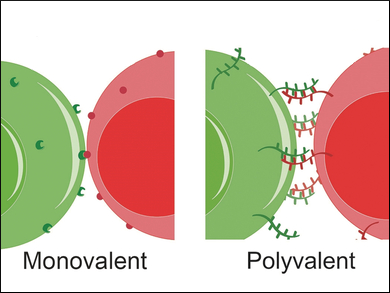Biomolecules on the surface of live cells determine cellular recognition and communication with the microenvironment. Existing methods are primarily focused on monovalent functionalization, that is, the display of single biomolecules across the cell surface. Polyvalent surface engineering could enhance or alter molecular recognition on cell surfaces.
Yong Wang and colleagues, Pennsylvania State University, University Park, USA, have developed a simple synthetic method for the plural display of biomolecules on the surface of live cells. Under physiological conditions, the team reacted deoxyribonucleic acid (DNA) initiators, displayed on the surface of a cell, with two types of DNA hairpin monomers. Upon polymerization, polyvalent DNA polymers were formed bearing multiple branches, each of which is a functional unit of molecular recognition.
The ability of the engineered cells to recognize nanoparticles and other live cells was studied. A polyvalent cell surface induced the formation of microscale constructs one order of magnitude larger compared with that of a unimolecular display. According to the researchers, the method holds promise for biomedical applications such as tissue engineering and nanoparticle delivery.
- Polyvalent Display of Biomolecules on Live Cells,
Peng Shi, Nan Zhao, Jinping Lai, James Coyne, Erin R. Gaddes, Yong Wang,
Angew. Chem. Int. Ed. 2018.
https://doi.org/10.1002/anie.201712596



